Resource Center
On-Line Library
DAILY NEBRASKA STATE JOURNAL, LINCOLN, SUNDAY 5 JUNE 1887 p25
THE WHOLESALE TRADE
Her Unequalled (sic) Facilities Destined to Put Her in the Front Rank - The Center of an Immense and Constantly Increasing Trade - Past Success But a Hint of the Future
A wholesale center is dependent primarily upon the facilities for collecting and distributing the wares of the world. The volume of its business will be gauged by the extent of the patronage it can command. That Lincoln possesses ample facilities for communication with the trade centers of the east and unequalled (sic) advantages for distribution, the consideration of her railroads conclusively shows. That the volume of business naturally tributary to the Capital city, is sufficient to warrant her claims as a wholesale center is also indicated by the tabulated list of a small number of the towns which she can justly include among her patrons. It inevitably follows that Lincoln offers inducements to the whole sale dealer not excelled by any city west of the Mississippi river. Like the spokes of a wheel her ten railroads stretch out in every direction, bringing the remote parts of the state into close communication with the Capital city. The other important towns of the state are located upon the circumference of the railroad wheel, of which Lincoln
It will be readily seen that Lincoln is thus the natural business center and distributing point of the state, and here eventually the largest and most successful business houses must be located. Merchants from the surrounding towns for a long distance can come in upon the morning trains, transact their business and return with the smallest possible expenditure of time. Orders by mail can be filled at Lincoln at least a day earlier than at any other jobbing point.
A great wholesale interest is not a thing of sudden growth. It possession means steady, persistent, energetic effort. Lincoln has strong rivals in the field, but this fact is looked upon as an encouraging feature by her numerous dealers. The elements which are to make Lincoln eventually successful in this line have been recognized from her earliest settlement.
The merchants who first located here had faith in the future of the city, and many of them from the first have done a profitable wholesale business in connection with their retail trade, and many who began with a small capital invested in a retail stock are now among the exclusive wholesale dealers whose success is closely identified with the prosperity of the city. Many merchants, too, have been drawn into the jobbing business, almost against their will. Purchasing in the cheapest markets on the continent, and being so fortunately located for distributing they have gradually developed a large jobbing trade without resorting to any of the means usually employed for securing it, and finding it profitable, have given more and more attention to this branch till in many instances it has become the most important department of the business.
No more conclusive evidence of
could be cited. These opportunities are being recognized and large investments and fresh capital are being attracted to almost every branch of trade. The returns are uniformly encouraging, in fact it is gratifying to note that no wholesale house with a fair capital and experience has ever failed to realize a reasonable success. Indeed the history of the city presents only one or two failures in this line of business for any cause. Success beyond anticipation is the rule, and the foundations for many fortunes have already been laid. To this fact the substantial stone, brick and iron business blocks and the elegant private residences of our business men amply testify. We doubt if another city of its age in the country can boast of streets lined with more substantial and beautiful buildings than are visible in the business part of Lincoln. Travellers (sic) who visit the west are surprised at the elegance displayed in the capital city and wonder that such a city can now stand upon what less than a quarter of a century ago was a stretch of unbroken prairie. With such marvelous development what does the future unfold!
Yet the jobbing trade of this city is
Never was there a time when industry and experience, backed by sufficient capital was surer of a reward. The increase of population; each year makes enormous demands upon the distributing centers. The success of Chicago is being duplicated in a modest way at a hundred points, and although the chronic grumblers in the past have doubted the substantial nature of our progress and predicted a reaction, the city has continued to advance and now promises to more than realize the most sanguine expectations of its founders. Such faith do our jobbers have in the future of the city and state that they warmly welcome new houses even in their own particular lines. They realize that every new firm is of vital assistance to each of the old ones, and that the total business that ought to be controlled by this city is so great that rivalry, far from injuring the trade of either, increases the business of both. Each new house adds to the reputation of the city as a distributing point, and thus draws customers to all the others. The best of feeling prevails among our wholesale houses and the heartiest welcome is given to new enterprises which promise to add to the prestige and prosperity of the city. This state has but
A vast number of its fertile acres have never felt the sharp edge of the plow. The oldest and most thickly settled counties contain but a small percentage of the population they are destined to sustain. No other country that that tributary to Lincoln can be found in the most favored parts of the globe. The famous valley of the Nile, enriched by the annual overflow of the river for untold ages, is not more productive than the rich soil of our unbounded prairies. What a few years ago was considered a waterless wilderness, fit only for the wild buffalo and the wilder Indian hunter, has been demonstrated capable of becoming the garden spot of the continent. The wealth of soil is drawing from all part of the United States and Europe a steady tide of the most enterprising and industrious people that ever settled in any country. Railroads are being pushed into the remotest sections. Eastern capital is coming in to develop the various natural resources. In short, the state is enjoying a growth almost unprecedented in the history of a country remarkable for the wonderful rapidity with which it has been developed.
Lincoln Transfer Co.,
DINGES, McGAHEY & CO.
We have twenty wagons on the street and are prepared to handle all kinds of merchandise, houshold goods, safes and heavy machinery. Latest improvements in truck of moving pianos. Office with E. T. Roberts, west side P. O. Square. TELEPHONE 178.
Window Screens.
We have the only perfect window screen in the market. Call at our office and see them. S. A. BROWN & Co.
Lumber Dealers, N st., bet. 8th and 9th
H. W. JOHNS ASBESTOS
LIQUID PAINTS
These Paints are in every respect strictly first-class, being composed of the best and purest materials obtainable. They have a larger sale than any other paints made in this country or abroad, and although they cost a trifle more per gallon, they will do more and better work for the same amount of money, owing to their wonderful covering properties, while their superior durability renders them the most economical paints in the world. Sample Sheets and Descriptive Price List free by mail.
SOLE MANUFACTURERS OF
H. W. Johns' Fire and
Water-Proof Asbestos Roofing, Sheathing, Building Felt, Asbestos
Steam Packings, Boiler Coverings, Roof Paints, Fire-Proof Paints,
etc. VULCABESTON. Moulded Piston, Red Packing, Rings, Gasket,
Sheet Packings, etc.
Established 1858.
175 RANDOLPH
ST., CHICAGO.
NEW
YORK, PHILADELPHIA, LONDON
Nichols Paint and Roofing Co., 820 P st., Lincoln
HENRY T. CLARKE, President. JNO. T. CLARKE, Vice President. WM. H. CLARKE, Treasurer.
CHAS J. DAUBACH, Secretary. W. C. MILLS, Manager
H. T. CLARKE DRUG COMPANY,
AUTHORIZED CAPITAL $200,000.
WHOLESALE DRUGGISTS.
PAINTS, OILS, WINDOW GLASS, ETC.
LINCOLN, NEB.
Telephone 259. Orders Promptly Executed.
JAMES H. O'NEILL,
Plumbing, Steam and Hot Water Heating,
Gas Fitting, Gas Fixtures, Iron, Lead and Sewer Pipe
Estimates Cheerfully Furnished. Correspondence
Solicited
125 No. 9th St., Lincoln.
A. T. LEMING & CO.
1106 O and 118 North Eleventh Streets.
DEALERS IN
Wall Paper, Window Shades,
Mouldings, Pictures and all kinds of Goods for Interior
Decorations.
You will find all the new coloraige and designs at
their store.
GARDEN
HOSE,
RUBBER HOSE, COTTON HOSE,
HOSE REELS, SPRINKLERS, NOZZLES
F. A. KORSMEYER & CO.
1303 O Street. Opp. Gorman National Bank.
Estimates given on Plumbing, Heating and Gas Fitting. Contractors are requested to call.
DAILY NEBRASKA STATE JOURNAL, LINCOLN, SUNDAY 5 JUNE 1887 p26
GRASSES AND FORAGE PLANTS
_________________
The Advantages That Nebraska
Offers as a Grazing District.
___________________
A Paper Expressly Prepared for This Edition By Dr. Chas. E. Bessey, University of Nebraska.
There are probably about one hundred species of plants in Nebraska which supply pasturage and hay to our domestic animals, not to mention those that are used as food in other ways. Nearly all these plants are grasses or grass like plants and most of them are natives of the region. A comparatively small number have been introduced within the last few years, and have thus added to the natural resources of the country.
I. The Grasses Proper.
These are all narrow leaved plants with jointed, and usually round, hollow stems. The bases of the leaves sheath the stems for an inch or more. These characters will distinguish the true grasses from all other plants to which the name of "grass" is frequently applied, such as the sedges, rushes, clovers, etc.
The grasses of the genus Panicum are very common, being found in all places and at all times from early spring to late fall. They may be recognized in most cases by the rounded, grainlike flowers (spikelets). One of the earliest of these has been in bloom for a couple of weeks. It has short and rather broad leaves, and its flowers which are about a sixteenth of an inch in diameter and look like small green shot, are in a loose spreading cluster at the top of the plant. The whole plant is not more than ten to twelve inches high. Later in the season many other species will appear, some of which attain a height of three feet or more as in the case of Panicum virgatum, an autumn species.
An introduced species, Panicum orus-galli, is the well known "barnyard grass" which is here regarded as a weed and unjustly considered to have no value. In some parts of the county, it is used for hay, for which it is very valuable. Another introduced species is Panicum millaccum, known as millet or Indian millet, and largely used in many parts of the world for its valuable hay.
We have no native foxtail grasses, just three species have been introduced into this region from other parts of the country, and originally from the old world. Two of these are of little or no value for forage, being mere weedy grasses, but the third Sclaria italica, is the well known and valuable Hungarian grass, which has been so extensively used for the production of hay in all parts of the west. Its rank growth upon the rich soil of the plains enables the farmer to supply his animals with an excellent hay when his perennial grasses fail him.
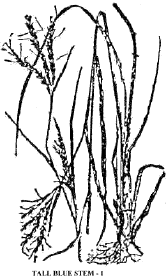
![]()
![]()
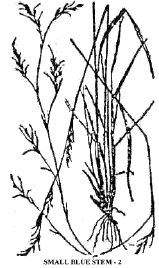 No
grasses of the prairies and plains are more striking than those to
which the common name of Blue Stem has been given. They grow in
bunches and at the period of flowering attain a height of from two
to four or even six feet. Before blossoming their long and
numerous leaves furnish large amounts of nutritious forage and
when their stem have shot up to their full height, few wild
grasses supply a more desirable hay. Several species are found in
this region. They have been distinguished by common names as
follows: The tallest one is known as Tall Blue Stem, Andropogon
provinciulis, and it frequently attains a height of five, or six
feet. The second is the small Blue Stem, Andropogon scoparius,
which is much shorter, but has much the same habit as the
preceding. The third one, known as Bushy Blue Stem, belongs to a
different genus and bears the name of Chrysopogon nutans. It is
the prettiest of the blue stems, attaining a height of from three
to four feet, and bearing a spreading top of golden brown flowers.
All the blue stems now grow in abundance upon the upland prairies
although there is evidence that not many years since they were
much less common than at present. With the changes, climatic or
otherwise, that have taken place since the settlement of this
region the blue stems have taken possession of the soil which
previously had been occupied by other and smaller species.
No
grasses of the prairies and plains are more striking than those to
which the common name of Blue Stem has been given. They grow in
bunches and at the period of flowering attain a height of from two
to four or even six feet. Before blossoming their long and
numerous leaves furnish large amounts of nutritious forage and
when their stem have shot up to their full height, few wild
grasses supply a more desirable hay. Several species are found in
this region. They have been distinguished by common names as
follows: The tallest one is known as Tall Blue Stem, Andropogon
provinciulis, and it frequently attains a height of five, or six
feet. The second is the small Blue Stem, Andropogon scoparius,
which is much shorter, but has much the same habit as the
preceding. The third one, known as Bushy Blue Stem, belongs to a
different genus and bears the name of Chrysopogon nutans. It is
the prettiest of the blue stems, attaining a height of from three
to four feet, and bearing a spreading top of golden brown flowers.
All the blue stems now grow in abundance upon the upland prairies
although there is evidence that not many years since they were
much less common than at present. With the changes, climatic or
otherwise, that have taken place since the settlement of this
region the blue stems have taken possession of the soil which
previously had been occupied by other and smaller species.
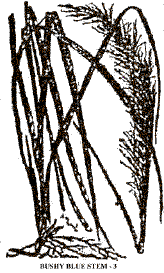
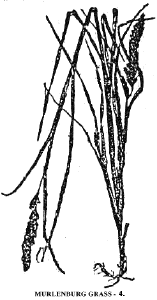 A
number of species of slender grasses may be grouped under the name
of the Muhlenberg grasses, a name given in honor of old Dr.
Muhlenberg of Pennsylvania, an enthusiastic student of the
grasses, but now long dead. These grasses are notable for the
large amount of flesh forming material which they contain, the
percentage being higher in one species than any other known grass.
This species is the Muhlenbergia glomosrata of the botanical
books, a branching grass which is quite common, especially upon
the rich moist soils which border the sloughs and "draws" of the
prairie. A nearly related species, Muhlenbergia mexicana, is also
common in similar situations and with the preceding, constitutes
much of the so called "fine slough grass" -- so much prized in
some localities by horsemen for making into hay. Other species
occur in the woodlands along the streams, and those yield a
valuable pasture.
A
number of species of slender grasses may be grouped under the name
of the Muhlenberg grasses, a name given in honor of old Dr.
Muhlenberg of Pennsylvania, an enthusiastic student of the
grasses, but now long dead. These grasses are notable for the
large amount of flesh forming material which they contain, the
percentage being higher in one species than any other known grass.
This species is the Muhlenbergia glomosrata of the botanical
books, a branching grass which is quite common, especially upon
the rich moist soils which border the sloughs and "draws" of the
prairie. A nearly related species, Muhlenbergia mexicana, is also
common in similar situations and with the preceding, constitutes
much of the so called "fine slough grass" -- so much prized in
some localities by horsemen for making into hay. Other species
occur in the woodlands along the streams, and those yield a
valuable pasture.
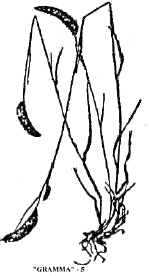
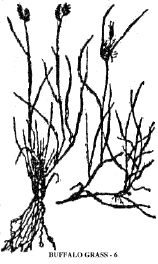 This
is one of the most interesting of our grasses, as it is one of the
smallest. It rarely exceeds three or four inches in height, and
has fine small leaves and stems. It grows in small bunches, but as
it sends out numerous runners it soon spreads over considerable
space, and make a pretty dense mat over the surface on the ground.
In one thing this grass is quite remarkable; its flowers are of
two kinds, viz; male and female, upon different plants. That is,
the stamens are borne upon one set of plants, while the pistils,
or young kernels, are born upon another set. Moreover, the two
kinds of flowers are of such different structure and appearance
that for many years they were supposed to belong to two entirely
distinct species. The staminate plant (on the left, fig 6) is
somewhat taller than the other, and bears at top two or three
little straw-colored spikes, which stand out from the main stem at
an angle. The other plant (on the right, fig. 6) bears a flower
cluster which bears some resemblance to the flower cluster of the
familiar Sand bur in its young state. I have often found the two
kinds of plants growing together in the same patch, but I have as
often found them widely separated. It is said that good seeds are
rarely formed, and this fact (if it be one) is probably due to the
separation of the two kinds of flowers.
This
is one of the most interesting of our grasses, as it is one of the
smallest. It rarely exceeds three or four inches in height, and
has fine small leaves and stems. It grows in small bunches, but as
it sends out numerous runners it soon spreads over considerable
space, and make a pretty dense mat over the surface on the ground.
In one thing this grass is quite remarkable; its flowers are of
two kinds, viz; male and female, upon different plants. That is,
the stamens are borne upon one set of plants, while the pistils,
or young kernels, are born upon another set. Moreover, the two
kinds of flowers are of such different structure and appearance
that for many years they were supposed to belong to two entirely
distinct species. The staminate plant (on the left, fig 6) is
somewhat taller than the other, and bears at top two or three
little straw-colored spikes, which stand out from the main stem at
an angle. The other plant (on the right, fig. 6) bears a flower
cluster which bears some resemblance to the flower cluster of the
familiar Sand bur in its young state. I have often found the two
kinds of plants growing together in the same patch, but I have as
often found them widely separated. It is said that good seeds are
rarely formed, and this fact (if it be one) is probably due to the
separation of the two kinds of flowers.